I Celebrated Día de los Muertos in Oaxaca, Mexico — Here's How I Planned My Once-in-a-lifetime Trip
On a visit to Oaxaca for the Day of the Dead festival, T+L executive editor Flora Stubbs pays tribute to her own family history while immersing herself in Mexico’s magical traditions.

Daniel Seung Lee
From left: A Día de los Muertos parade on Calle Macedonio Alcalá, in Oaxaca, Mexico; a doorway in Oaxaca City adorned with marigolds, which are believed to attract the souls of the dead.I think it must have been my mother’s mom, Moyra, from whom I inherited my love of travel. Widowed in her sixties, she used her late husband’s pension to fund a succession of solo trips, each more ambitious than the last. I still remember the photos: Moyra cruising the Danube; Moyra in front of the Pyramids; Moyra in Tiananmen Square, looking sharp as ever in her panama hat.
My grandmother lived to 103, but she never made it to Mexico. Almost a decade after she passed away, I was invited to Oaxaca for Día de los Muertos, or the Day of the Dead. “Darling, how wonderful,” I could almost hear her saying. The organizers told me I could bring a picture of a deceased relative to honor at the festival. So I dug out Moyra’s photo, tucked it in my hand luggage, and off the two of us went.
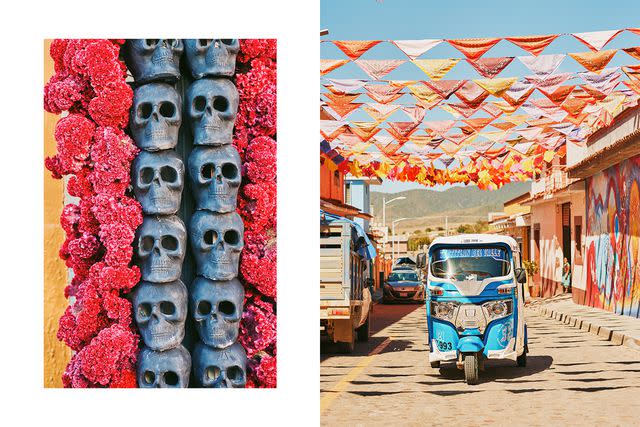
Daniel Seung Lee
From left: Día de los Muertos decorations on the streets of Oaxaca City; festival banners on a street in Teotitlán del Valle, a community of artisans outside Oaxaca.Día de los Muertos, as anyone who has seen the Disney movie Coco will tell you, is one of Latin America’s most culturally significant and visually exuberant holidays — and many people see the city of Oaxaca, in southern Mexico, as its epicenter. In late October and early November, the cobblestoned streets erupt with costume parades, cemeteries glow with candlelight, and inside every home an ofrenda, or altar, is set up to commemorate loved ones who have passed away.
I was joining a group trip arranged by Prior, a travel company that, since launching in 2018, has acquired a reputation for curating experiences that combine authenticity with a perfectly curated, Instagram-ready aesthetic. (A robust celebrity client list hasn’t damaged its cachet, either.) A new series of itineraries, launched in collaboration with Capital One, is geared around festivals; Día de los Muertos would be the first.
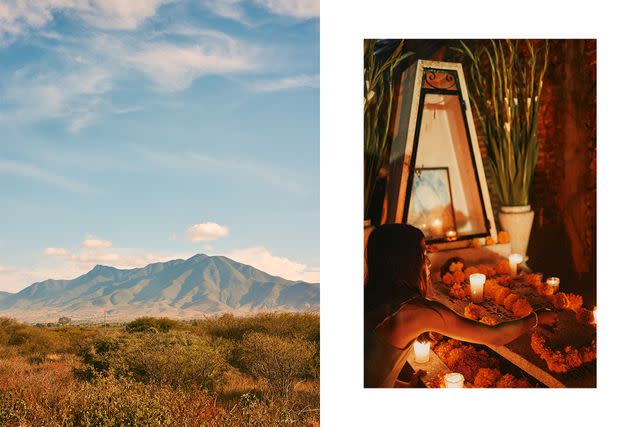
Daniel Seung Lee
From left: A view of the hills outside Oaxaca City; a grave in Xochimilco cemetery during Día de los Muertos.Our base was Escondido Oaxaca, a century-old mansion in the Centro Histórico that in 2019 was converted into a boutique hotel by Grupo Habita — these days a byword for cool, contemporary lodgings in Mexico and beyond. Stepping through the hotel’s heavy wooden doors, I found myself in a courtyard filled with marigolds, thought to attract the souls of the dead with their heady perfume and orange blooms. Inside my room, on a bed that seemed to levitate above a concrete floor, lay a little dish containing two dark-chocolate skulls flavored with mandarin and marigold from FlorCacao, a Oaxacan artisanal chocolatier.
"A tide of thousands flowed past. In the parade we saw fireworks, drummers, and multiple brass bands. There were men on stilts and women carrying three-foot floral arrangements in baskets on their heads. Some wore riotous, rainbow-colored costumes; others were in black and white."
An hour or so later my group — for this preview trip, a mix of mostly writers and photographers — gathered for cocktails on Escondido’s rooftop. I raised a mezcal margarita with David Prior, who founded the company after starting out in the food and publishing industries. He told me about the idea behind the new series, which will see other groups travel to Paris for Bastille Day and Seville, Spain, for the Feria de Jerez festival. “These events are when the culture is at its most emblematic,” he explained. Coming up with the right itinerary isn’t always easy, though — especially at an event like the Day of the Dead, when non-Hispanic people in skull makeup have been accused of cultural appropriation. As Prior put it, “How do you make it feel real, but also magical?”
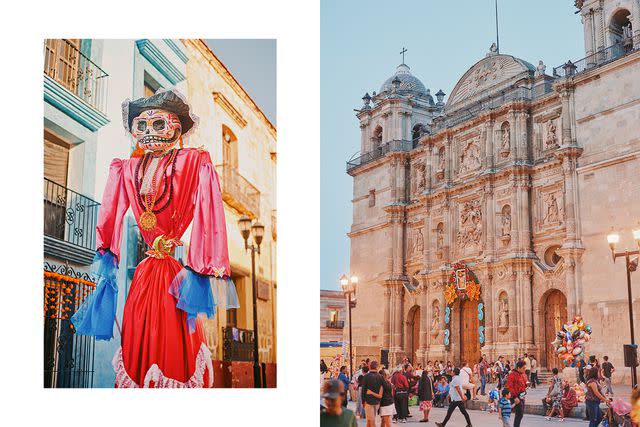
Daniel Seung Lee
From left: A giant mannequin in a Día de los Muertos parade; Oaxaca City's cathedral.As if in response, we heard music floating up from the courtyard. A troupe of musicians and dancers had arrived, summoning us down from the roof and out onto the street. Swept up in their trail of color, movement, and sound, we came to an intersection where a crowd was gathered. Beyond it, a tide of thousands flowed past. In the parade we saw fireworks, drummers, and multiple brass bands. There were men on stilts and women carrying three-foot floral arrangements in baskets on their heads. Some wore riotous, rainbow-colored costumes; others were in black and white. Many of their faces were painted to resemble La Calavera Catrina, the skeleton cartoon that has come to symbolize the festival. Overhead, pink and orange banners fluttered against an inky night sky. It was joyful, and haunting, and completely unique to this place and time. Día de los Muertos had begun.
The Day of the Dead originated some 3,000 years ago with the Aztecs, who established a ritual honoring Mictecacihuatl, the goddess who guarded the underworld. When the Spanish arrived in the 16th century, the event was subsumed by the solemn Catholic rituals of All Saints’ Day and All Souls’ Day; five hundred years later, Día de los Muertos has taken on its own distinct identity — so much so that, in 2008, it was added to UNESCO’s Intangible Cultural Heritage list.
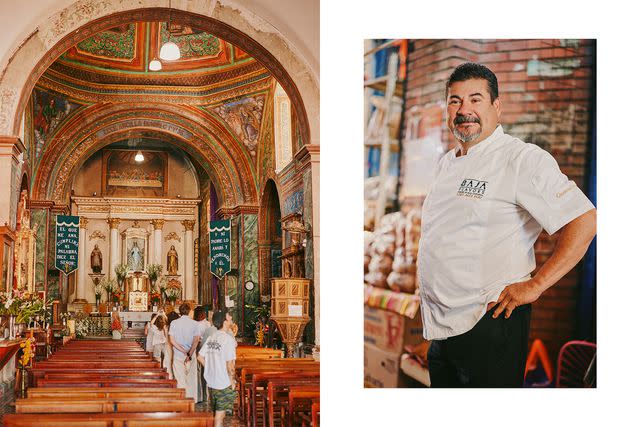
Daniel Seung Lee
From left: Visiting the Iglesia Preciosa Sangre de Cristo, in Teotitlán del Valle; Chef Alejandro Ruiz of Portozuelo and Casa Oaxaca El Restaurante.To get a better sense of its significance, we drove the next morning to Teotitlán del Valle, about 45 minutes outside the city. This rural town, home to a community of Indigenous Zapotec weavers and dyers, also happened to be the birthplace and home of our guide, Edgar Mendoza Martinez. After a quick tour of Teotitlán’s market and main square, he ushered us inside his family’s red-roofed compound. In a central courtyard where roosters picked away beneath a pomegranate tree and six-foot lengths of sugarcane were stacked against a wall, we met Edgar’s cousin, who he calls Tia Micaelina.
A diminutive woman in a traditional braided headband and apron, Micaelina led us into a room where a large ofrenda had been set up for the holiday. In front of a wall of Catholic icons in gold frames, the smoke of copal, the Mesoamerican incense, cut swirls through shafts of sunlight. Micaelina pointed out photos of her parents and miniature loaves of bread and pieces of chocolate that had been arranged on a table below the shrine to attract the souls of los angelitos, or children who had died. I asked Edgar if any angelitos had departed from this household. “Yes,” he replied. “Her little sister was lost.”
I thought about my photo of Moyra — which, unfortunately, I’d left back at the hotel. “You’ll know when you find the right ofrenda to leave it on,” Edgar had said when I’d asked him about it on the first day. This, clearly, wasn’t the one.
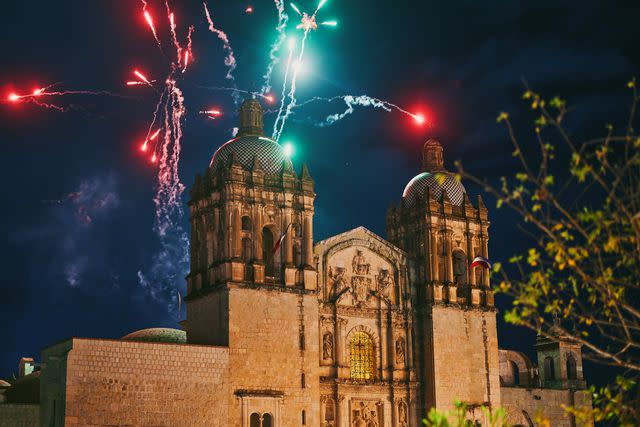
Daniel Seung Lee
Fireworks over Templo de Santo Domingo de Guzmán, as seen from Cobarde restaurant, in Oaxaca City.Craft is a big focus on Prior trips, and Oaxaca’s riot of artisan traditions, from basketry and woodcarving to embroidery and pottery, make it the perfect place for visitors to learn about, and purchase, the delightful decorative objects Oaxacan people have produced for centuries.
In Zapotec communities like Teotitlán del Valle, entire families — often, whole towns — typically specialize in a single craft. For generations, Edgar told us, his ancestors had been weavers. By becoming a tour guide, he had been among the first to break away. ”I knew, if I wanted to understand the world, I had to run from that,” he said.
Others in Teotitlán del Valle have found a way to keep their family’s vocation alive while looking outward, and to the future. In a nearby compound we met Alejandro Mendoza and Verónica Bautista, a married couple who run Casa Don Taurino. This dyeing and weaving workshop was set up by Mendoza’s grandfather; under the young couple’s stewardship it has, over the past few years, focused on reviving the centuries-old use of organic pigments.
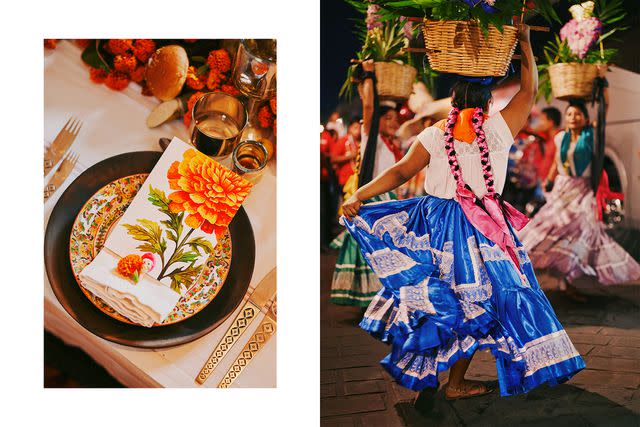
Daniel Seung Lee
From left: Place settings for a private hacienda dinner; a troupe of chinas oaxaqueñas dancers greeting Prior guests outside Escondido Oaxaca.“Natural dyes were being replaced with synthetic pigments,” Mendoza told us. “This tradition was getting lost.” He pointed to wooden bowls of ingredients lined up on the floor: dried pomegranate skins, used to make a mustard-colored dye; marigold flowers for yellow; tree moss for beige; leaves of the Indigofera plant for indigo.
One bowl held a silvery, grainlike material: la grana cochinilla, or cochineal, an insect that lives on the prickly-pear cactus. When cooked and crushed, they release a rich scarlet dye. When the Spanish arrived in Oaxaca, Mendoza said, they were amazed to find that these unlikely bugs yielded a stronger red than they’d been able to create back home, so they shipped the dye to Europe. At one point, he said, “it was almost comparable to gold in value.”
"It felt a little like being in the presence of a queen when Alávez gestured for me to sit on the earth floor of her workshop, at the foot of her wooden stool, and try making a fuchsia wax rosette."
Bautista began crushing a handful of cochinilla with a rolling pin, and gradually a patch of bright scarlet appeared. We applied the dye to the palms of our hands, noting the subtly different shades created by our individual skin chemistry. Next, we submerged squares of cotton fabric in a vat of indigo dye, creating tie-dyed designs in a deep, resounding blue. Finally we met a young designer, Angélica Torres Ospina, who, in a next-door workshop, makes chic cotton and linen clothing, all of it dyed with her neighbors’ natural pigments.
Elsewhere in Teotitlán, artisans have taken their creations from the workshop to the world stage. A few streets from Casa Don Taurino we arrived at Casa Viviana, the atelier of 76-year-old candlemaker Viviana Alávez, which has acquired 24,000 followers on Instagram. She has even been featured in Vogue.
The stately, silver-haired Alávez and her daughter-in-law, Petra Mendoza, make traditional velas — Oaxacan candles with wax adornments around the base. In reimagining their velas as fantastical sculptures, the women have acquired a reputation as the undisputed masters of the art. Even the most basic candles come in a dazzling array of colors and are adorned with flowers, shells, or skulls; some centerpieces, custom-made for weddings and festivals like Día de los Muertos, can be six feet tall and take up to two months to make.
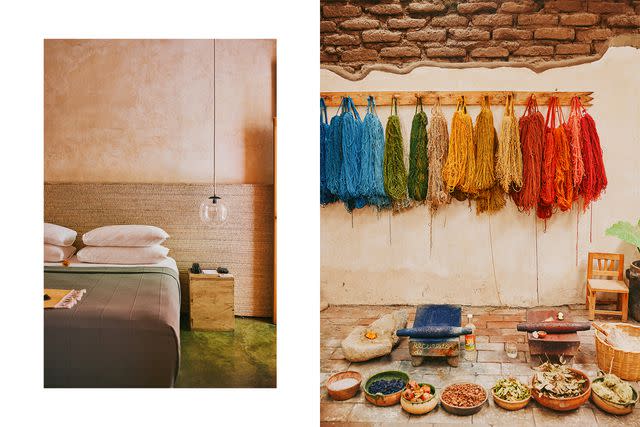
Daniel Seung Lee
From left: Minimalist décor at the hotel Escondido Oaxaca; making natural dyes at Casa Don Taurino.Though the women use methods that have remained unchanged for generations (beeswax from the state of Chiapas is dyed with natural pigments, including cochineal, and molded by hand or with wooden tools), they’ve become known for creating bold designs, often using floral motifs inspired by the surrounding countryside. Some credit Alávez for single-handedly keeping the tradition alive.
So it felt a little like being in the presence of a queen when Alávez gestured for me to sit on the earth floor of her workshop, at the foot of her wooden stool, and try making a fuchsia wax rosette. The result wasn’t a complete embarrassment, but it couldn’t compare with the pieces for sale at Casa Viviana. My group spent the better part of the next hour deliberating over which candles to buy, then waiting as Alávez’s relatives carefully wrapped and boxed each one. (One brilliant service offered on Prior’s trips with Capital One: your purchases are shipped home, direct from your hotel room.)
Prior’s other big focus is food, and in Oaxaca, you don’t have to look far to find meals that will expand your ideas of Mexican cuisine, whether the tablecloth is made of vinyl or white linen. In Teotitlán del Valle, we watched women make tortillas and quesadillas over an open flame, then devoured them hot from the stove, daubed with a zesty avocado salsa. At La Cocina de Humo, a restaurant in Oaxaca City, we sat at a long, candlelit table as chef Thalía Barrios and her team re-created the rich, smoky flavors of the Sierra Sur region, cooking everything over a wood-burning stove and serving it on stylish earthenware from small regional producers.
"In Teotitlán del Valle, we watched women make tortillas and quesadillas over an open flame, then devoured them hot from the stove, daubed with a zesty avocado salsa."
But our most memorable meal was the one we cooked ourselves. Early on our second morning, we set off to the Mercado Central de Abastos with chef Alejandro Ruiz, whose Casa Oaxaca El Restaurante is credited with introducing the region’s food to the world. “Everything starts at the market,” Ruiz said. “I’ve been shopping here since I was a child — more than forty years.”
Like a beacon in his chef’s whites, Ruiz led us through the market’s endless alleys, stopping every now and then to make small talk with a stallholder or to take a selfie with a fan. Produce was piled high at every window, alongside a cacophony of Día de los Muertos décor: skulls made of sugar, papier-mâché skeletons, massive banks of marigolds, and papel picado, or cut-out paper flags in rainbow colors.
While the group stopped every 15 seconds to take pictures and buy souvenirs, Ruiz stayed on point, picking out a whole chicken, bright yellow feet still attached; a big, bulbous squash; tomatoes and tomatillos; avocado leaves; thyme and oregano. At one kiosk, we inspected an array of dried chiles arranged in open sacks. Ruiz picked up a bag of the largest variety, chilhuacle rojo, to add to the mole we’d be making that afternoon. “This one is smoky, with umami and mineral flavors,” he said.

Daniel Seung Lee
A candle-making demonstration at Casa Viviana, in Teotitlán del Valle.Bags heaving, we headed to Portozuelo, the idyllic farm outside Oaxaca City where Ruiz grew up, and where he developed a profound connection with the land and its produce. Today the farm has a restaurant and event space where everything is cooked in the traditional Oaxacan way: over an open wood fire, using ingredients from the local market or grown on site.
Portozuelo employs around 35 members of the community as cooks and servers, a handful of whom greeted us with trays of ice-cold beers and mezcal cocktails as we arrived at the kitchen-dining space, a tile-roofed structure that’s open to the elements on all sides. Ruiz divided the group into teams: mine would be making mole, the notoriously complex sauce that, for this iteration, required 28 ingredients. Happily, my fellow members turned out to be kitchen experts; one of them, the author of multiple cookbooks, immediately took control of the grill to char plantains, tomatoes, onions, spices, and herbs.
Related: 7 Under-the-radar Beach Towns in Mexico
Still, it wasn’t until mid-afternoon that we sat down to lunch at a long wooden table, sharing big bowls of deliciously rich traditional mole, as well as a green version with chicken added, and, for dessert, fresh pan de muertos — delicate buns coated with sesame seeds, each studded with a tiny carita, or sugar face.
The last night of our trip coincided with the first of the two main nights of the Día de los Muertos celebration, and excitement was building as we gathered at Cobarde Oaxaca, a restaurant that overlooks the city’s zocalo, or main square. From a table on the second-floor terrace we watched passersby on the cobblestones below take pictures of street performers in elaborate costumes. Their backdrop was the floodlit façade of the Templo de Santo Domingo de Guzmán — which, for a few delightful minutes, was even framed by fireworks.
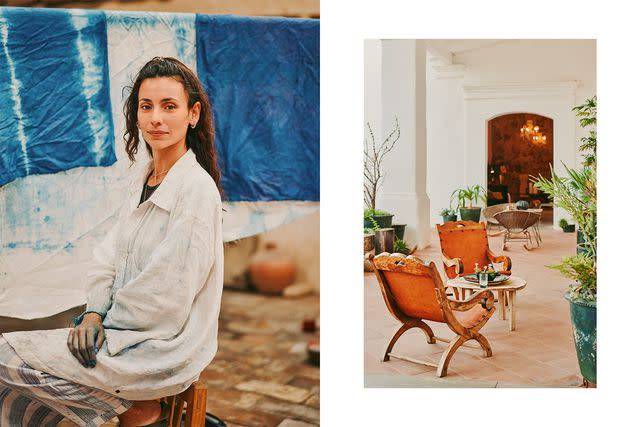
Daniel Seung Lee
From left: Designer Angélica Torres Ospina, who dyes her clothing with organic pigments made at Casa Don Taurino; the hacienda setting for a private dinner arranged by the travel company Prior.Four phenomenal courses later, we were finishing our smoked tres leches cake when Edgar took a call from a contact, who said strong breezes were blowing out all the candles in the main cemetery. Instead, Edgar announced, we’d go to Xochimilco, a smaller burial site in a residential neighborhood. Clouds scudded across a silvery half-moon as we passed through the gates and made our way to the
edge of the cemetery, where a group of women and girls were gathered around a grave that glowed with the light of votive candles. They told us they were there to honor Maria, the family matriarch.
Two of the woman’s young granddaughters, their faces painted like skulls, tended the candles. Maria’s daughters, resplendent in marigold headdresses, passed around shots of mezcal in little plastic cups and sang “Amor Eterno,” a beloved funeral standard by the Mexican singer-songwriter Juan Gabriel. We saw similar family groups at other graves. Around some the atmosphere was festive; at others, perhaps more recently dug, the mood was subdued.
As we left the cemetery, I asked Edgar about his plans for the rest of the celebration. He told me he’d return to Teotitlán del Valle the next day to honor his father, who passed away 10 years ago. Talking about his father with visitors brought up complicated emotions, he added. “He always wanted to be a tour guide,” Edgar said. “I used to feel guilty, but then I realized the best way to honor him was to do this work.”
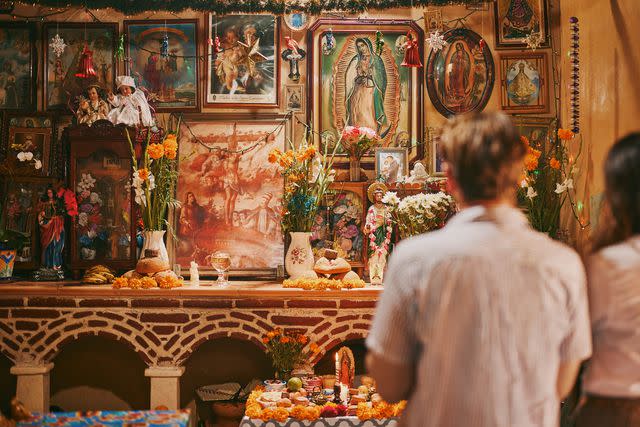
Daniel Seung Lee
An ofrenda at Prior guide Edgar Mendoza's family home in Teotitlán del Valle.It was almost time to leave Oaxaca, but I still hadn’t found a suitable ofrenda for my grandmother’s picture. Heading out into the Centro Histórico to get a coffee before I set off for the airport the next morning, I passed Casa Oaxaca, Alejandro Ruiz’s hotel and restaurant. Inside I found a tranquil courtyard where guests sat drinking coffee and eating a late, leisurely breakfast and, to one side, a large ofrenda lined with photos of the chef’s friends and family in ornate silver frames.
There, amid a cornucopia of candles, fruits, nuts, flowers, sugar skulls, and bottles of Corona, I left my photo of Moyra, smiling away. She wasn’t a beer drinker; red wine was more her thing. But I knew she would have loved this place — its warmth, its color, its sense of occasion. What an adventure, I could hear her say as I walked out into the sunlit street.
Four-day Día de los Muertos trips with Prior and Capital One from $2,400 per person.
A version of this story first appeared in the March 2024 issue of Travel + Leisure under the headline "Good Spirits."
For more Travel & Leisure news, make sure to sign up for our newsletter!
Read the original article on Travel & Leisure.

